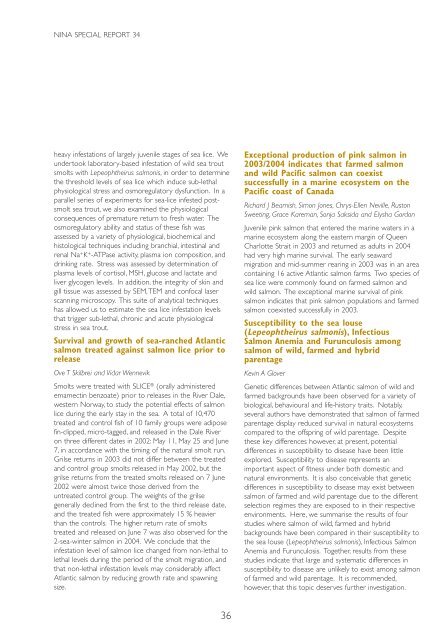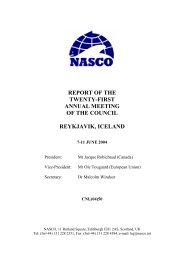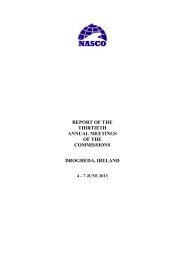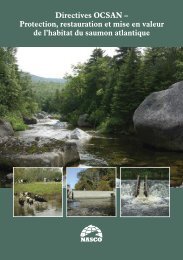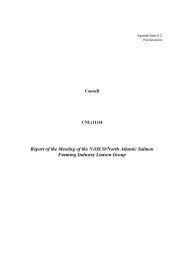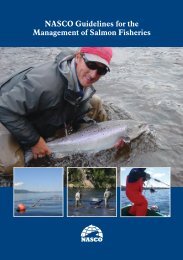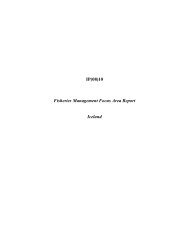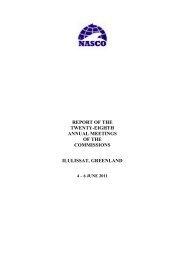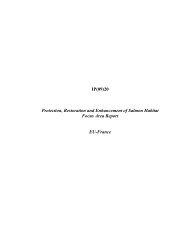Report of the 2005 ICES/NASCO Symposium on Interactions ...
Report of the 2005 ICES/NASCO Symposium on Interactions ...
Report of the 2005 ICES/NASCO Symposium on Interactions ...
Create successful ePaper yourself
Turn your PDF publications into a flip-book with our unique Google optimized e-Paper software.
NINA SPECIAL REPORT 34<br />
heavy infestati<strong>on</strong>s <str<strong>on</strong>g>of</str<strong>on</strong>g> largely juvenile stages <str<strong>on</strong>g>of</str<strong>on</strong>g> sea lice. We<br />
undertook laboratory-based infestati<strong>on</strong> <str<strong>on</strong>g>of</str<strong>on</strong>g> wild sea trout<br />
smolts with Lepeoph<str<strong>on</strong>g>the</str<strong>on</strong>g>irus salm<strong>on</strong>is, in order to determine<br />
<str<strong>on</strong>g>the</str<strong>on</strong>g> threshold levels <str<strong>on</strong>g>of</str<strong>on</strong>g> sea lice which induce sub-lethal<br />
physiological stress and osmoregulatory dysfuncti<strong>on</strong>. In a<br />
parallel series <str<strong>on</strong>g>of</str<strong>on</strong>g> experiments for sea-lice infested postsmolt<br />
sea trout, we also examined <str<strong>on</strong>g>the</str<strong>on</strong>g> physiological<br />
c<strong>on</strong>sequences <str<strong>on</strong>g>of</str<strong>on</strong>g> premature return to fresh water. The<br />
osmoregulatory ability and status <str<strong>on</strong>g>of</str<strong>on</strong>g> <str<strong>on</strong>g>the</str<strong>on</strong>g>se fish was<br />
assessed by a variety <str<strong>on</strong>g>of</str<strong>on</strong>g> physiological, biochemical and<br />
histological techniques including branchial, intestinal and<br />
renal Na + K + -ATPase activity, plasma i<strong>on</strong> compositi<strong>on</strong>, and<br />
drinking rate. Stress was assessed by determinati<strong>on</strong> <str<strong>on</strong>g>of</str<strong>on</strong>g><br />
plasma levels <str<strong>on</strong>g>of</str<strong>on</strong>g> cortisol, MSH, glucose and lactate and<br />
liver glycogen levels. In additi<strong>on</strong>, <str<strong>on</strong>g>the</str<strong>on</strong>g> integrity <str<strong>on</strong>g>of</str<strong>on</strong>g> skin and<br />
gill tissue was assessed by SEM,TEM and c<strong>on</strong>focal laser<br />
scanning microscopy. This suite <str<strong>on</strong>g>of</str<strong>on</strong>g> analytical techniques<br />
has allowed us to estimate <str<strong>on</strong>g>the</str<strong>on</strong>g> sea lice infestati<strong>on</strong> levels<br />
that trigger sub-lethal, chr<strong>on</strong>ic and acute physiological<br />
stress in sea trout.<br />
Survival and growth <str<strong>on</strong>g>of</str<strong>on</strong>g> sea-ranched Atlantic<br />
salm<strong>on</strong> treated against salm<strong>on</strong> lice prior to<br />
release<br />
Ove T Skilbrei and Vidar Wennevik<br />
Smolts were treated with SLICE ® (orally administered<br />
emamectin benzoate) prior to releases in <str<strong>on</strong>g>the</str<strong>on</strong>g> River Dale,<br />
western Norway, to study <str<strong>on</strong>g>the</str<strong>on</strong>g> potential effects <str<strong>on</strong>g>of</str<strong>on</strong>g> salm<strong>on</strong><br />
lice during <str<strong>on</strong>g>the</str<strong>on</strong>g> early stay in <str<strong>on</strong>g>the</str<strong>on</strong>g> sea. A total <str<strong>on</strong>g>of</str<strong>on</strong>g> 10,470<br />
treated and c<strong>on</strong>trol fish <str<strong>on</strong>g>of</str<strong>on</strong>g> 10 family groups were adipose<br />
fin-clipped, micro-tagged, and released in <str<strong>on</strong>g>the</str<strong>on</strong>g> Dale River<br />
<strong>on</strong> three different dates in 2002: May 11, May 25 and June<br />
7, in accordance with <str<strong>on</strong>g>the</str<strong>on</strong>g> timing <str<strong>on</strong>g>of</str<strong>on</strong>g> <str<strong>on</strong>g>the</str<strong>on</strong>g> natural smolt run.<br />
Grilse returns in 2003 did not differ between <str<strong>on</strong>g>the</str<strong>on</strong>g> treated<br />
and c<strong>on</strong>trol group smolts released in May 2002, but <str<strong>on</strong>g>the</str<strong>on</strong>g><br />
grilse returns from <str<strong>on</strong>g>the</str<strong>on</strong>g> treated smolts released <strong>on</strong> 7 June<br />
2002 were almost twice those derived from <str<strong>on</strong>g>the</str<strong>on</strong>g><br />
untreated c<strong>on</strong>trol group. The weights <str<strong>on</strong>g>of</str<strong>on</strong>g> <str<strong>on</strong>g>the</str<strong>on</strong>g> grilse<br />
generally declined from <str<strong>on</strong>g>the</str<strong>on</strong>g> first to <str<strong>on</strong>g>the</str<strong>on</strong>g> third release date,<br />
and <str<strong>on</strong>g>the</str<strong>on</strong>g> treated fish were approximately 15 % heavier<br />
than <str<strong>on</strong>g>the</str<strong>on</strong>g> c<strong>on</strong>trols. The higher return rate <str<strong>on</strong>g>of</str<strong>on</strong>g> smolts<br />
treated and released <strong>on</strong> June 7 was also observed for <str<strong>on</strong>g>the</str<strong>on</strong>g><br />
2-sea-winter salm<strong>on</strong> in 2004. We c<strong>on</strong>clude that <str<strong>on</strong>g>the</str<strong>on</strong>g><br />
infestati<strong>on</strong> level <str<strong>on</strong>g>of</str<strong>on</strong>g> salm<strong>on</strong> lice changed from n<strong>on</strong>-lethal to<br />
lethal levels during <str<strong>on</strong>g>the</str<strong>on</strong>g> period <str<strong>on</strong>g>of</str<strong>on</strong>g> <str<strong>on</strong>g>the</str<strong>on</strong>g> smolt migrati<strong>on</strong>, and<br />
that n<strong>on</strong>-lethal infestati<strong>on</strong> levels may c<strong>on</strong>siderably affect<br />
Atlantic salm<strong>on</strong> by reducing growth rate and spawning<br />
size.<br />
Excepti<strong>on</strong>al producti<strong>on</strong> <str<strong>on</strong>g>of</str<strong>on</strong>g> pink salm<strong>on</strong> in<br />
2003/2004 indicates that farmed salm<strong>on</strong><br />
and wild Pacific salm<strong>on</strong> can coexist<br />
successfully in a marine ecosystem <strong>on</strong> <str<strong>on</strong>g>the</str<strong>on</strong>g><br />
Pacific coast <str<strong>on</strong>g>of</str<strong>on</strong>g> Canada<br />
Richard J Beamish, Sim<strong>on</strong> J<strong>on</strong>es, Chrys-Ellen Neville, Rust<strong>on</strong><br />
Sweeting, Grace Kareman, S<strong>on</strong>ja Saksida and Elysha Gord<strong>on</strong><br />
Juvenile pink salm<strong>on</strong> that entered <str<strong>on</strong>g>the</str<strong>on</strong>g> marine waters in a<br />
marine ecosystem al<strong>on</strong>g <str<strong>on</strong>g>the</str<strong>on</strong>g> eastern margin <str<strong>on</strong>g>of</str<strong>on</strong>g> Queen<br />
Charlotte Strait in 2003 and returned as adults in 2004<br />
had very high marine survival. The early seaward<br />
migrati<strong>on</strong> and mid-summer rearing in 2003 was in an area<br />
c<strong>on</strong>taining 16 active Atlantic salm<strong>on</strong> farms. Two species <str<strong>on</strong>g>of</str<strong>on</strong>g><br />
sea lice were comm<strong>on</strong>ly found <strong>on</strong> farmed salm<strong>on</strong> and<br />
wild salm<strong>on</strong>. The excepti<strong>on</strong>al marine survival <str<strong>on</strong>g>of</str<strong>on</strong>g> pink<br />
salm<strong>on</strong> indicates that pink salm<strong>on</strong> populati<strong>on</strong>s and farmed<br />
salm<strong>on</strong> coexisted successfully in 2003.<br />
Susceptibility to <str<strong>on</strong>g>the</str<strong>on</strong>g> sea louse<br />
(Lepeoph<str<strong>on</strong>g>the</str<strong>on</strong>g>irus salm<strong>on</strong>is), Infectious<br />
Salm<strong>on</strong> Anemia and Furunculosis am<strong>on</strong>g<br />
salm<strong>on</strong> <str<strong>on</strong>g>of</str<strong>on</strong>g> wild, farmed and hybrid<br />
parentage<br />
Kevin A Glover<br />
Genetic differences between Atlantic salm<strong>on</strong> <str<strong>on</strong>g>of</str<strong>on</strong>g> wild and<br />
farmed backgrounds have been observed for a variety <str<strong>on</strong>g>of</str<strong>on</strong>g><br />
biological, behavioural and life-history traits. Notably,<br />
several authors have dem<strong>on</strong>strated that salm<strong>on</strong> <str<strong>on</strong>g>of</str<strong>on</strong>g> farmed<br />
parentage display reduced survival in natural ecosystems<br />
compared to <str<strong>on</strong>g>the</str<strong>on</strong>g> <str<strong>on</strong>g>of</str<strong>on</strong>g>fspring <str<strong>on</strong>g>of</str<strong>on</strong>g> wild parentage. Despite<br />
<str<strong>on</strong>g>the</str<strong>on</strong>g>se key differences however, at present, potential<br />
differences in susceptibility to disease have been little<br />
explored. Susceptibility to disease represents an<br />
important aspect <str<strong>on</strong>g>of</str<strong>on</strong>g> fitness under both domestic and<br />
natural envir<strong>on</strong>ments. It is also c<strong>on</strong>ceivable that genetic<br />
differences in susceptibility to disease may exist between<br />
salm<strong>on</strong> <str<strong>on</strong>g>of</str<strong>on</strong>g> farmed and wild parentage due to <str<strong>on</strong>g>the</str<strong>on</strong>g> different<br />
selecti<strong>on</strong> regimes <str<strong>on</strong>g>the</str<strong>on</strong>g>y are exposed to in <str<strong>on</strong>g>the</str<strong>on</strong>g>ir respective<br />
envir<strong>on</strong>ments. Here, we summarise <str<strong>on</strong>g>the</str<strong>on</strong>g> results <str<strong>on</strong>g>of</str<strong>on</strong>g> four<br />
studies where salm<strong>on</strong> <str<strong>on</strong>g>of</str<strong>on</strong>g> wild, farmed and hybrid<br />
backgrounds have been compared in <str<strong>on</strong>g>the</str<strong>on</strong>g>ir susceptibility to<br />
<str<strong>on</strong>g>the</str<strong>on</strong>g> sea louse (Lepeoph<str<strong>on</strong>g>the</str<strong>on</strong>g>irus salm<strong>on</strong>is), Infectious Salm<strong>on</strong><br />
Anemia and Furunculosis. Toge<str<strong>on</strong>g>the</str<strong>on</strong>g>r, results from <str<strong>on</strong>g>the</str<strong>on</strong>g>se<br />
studies indicate that large and systematic differences in<br />
susceptibility to disease are unlikely to exist am<strong>on</strong>g salm<strong>on</strong><br />
<str<strong>on</strong>g>of</str<strong>on</strong>g> farmed and wild parentage. It is recommended,<br />
however, that this topic deserves fur<str<strong>on</strong>g>the</str<strong>on</strong>g>r investigati<strong>on</strong>.<br />
36


